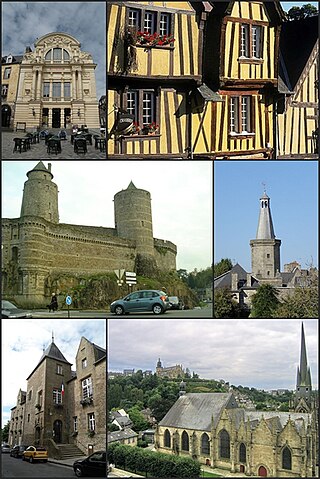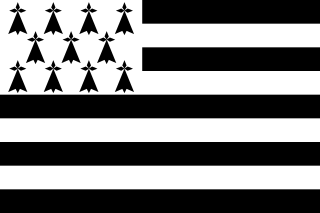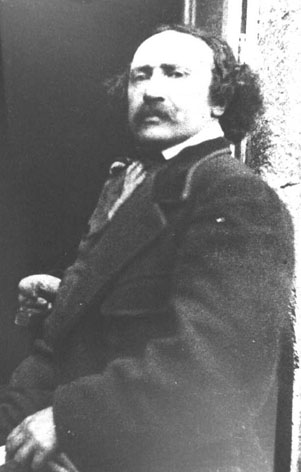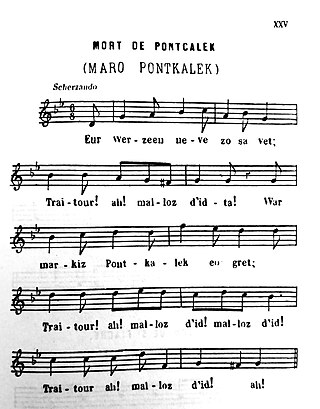Related Research Articles

Brittany is a peninsula, historical country and cultural area in the north-west of modern France, covering the western part of what was known as Armorica during the period of Roman occupation. It became an independent kingdom and then a duchy before being united with the Kingdom of France in 1532 as a province governed as a separate nation under the crown.
Since the early 1970s, Brittany has experienced a tremendous revival of its folk music. Along with flourishing traditional forms such as the bombard-biniou pair and fest-noz ensembles incorporating other additional instruments, it has also branched out into numerous subgenres.

Denez Prigent is a Breton folk singer-songwriter of the gwerz and kan ha diskan styles of Breton music. From his debut at the age of 16, he was known for singing traditional songs a cappella, and has moved on to singing his own songs with techno music accompaniments. He has performed in France as well as internationally and has recorded seven studio and two live albums.
"Bro Gozh ma Zadoù" is the anthem of Brittany. It is sung to the same tune as that of the national anthem of Wales, "Hen Wlad Fy Nhadau", and has similar lyrics. The Cornish anthem, "Bro Goth Agan Tasow", is also sung to the same tune.

Fougères is a commune and a sub-prefecture of the Ille-et-Vilaine department, located in Brittany, northwestern France. As of 2017, Fougères had 20,418 inhabitants. The Fougères area comprises approximately 88,000 inhabitants and is currently growing, unlike the town centre.

The history of Brittany may refer to the entire history of the Armorican peninsula or only to the creation and development of a specifically Brythonic culture and state in the Early Middle Ages and the subsequent history of that state.

The flag of Brittany, a region in the northwest of France, is called the Gwenn-ha-du, which means white and black, in Breton. The flag was designed in 1923 by Morvan Marchal. It is also unofficially used in the department of Loire-Atlantique, although this now belongs to the Pays de la Loire and not to the region of Brittany, as the territory of Loire-Atlantique is historically part of the province of Brittany. Nantes, its prefecture, was once one of the two capital cities of Brittany.

The Chouannerie was a royalist uprising or counter-revolution in twelve of the western départements of France, particularly in the provinces of Brittany and Maine, against the First Republic during the French Revolution. It played out in three phases and lasted from spring 1794 to 1800.

Gilles Servat is a French singer, born in Tarbes in southern France in 1945, into a family whose roots lay in the Nantes region of Brittany. He is an ardent promoter ardent of the Breton culture, and sings in both French and Breton, as well as the other celtic languages, and was a member of Dan ar Braz's Héritage des Celtes. He is also a poet and novelist.

Yves Lainé is a Breton lawyer, politician and companies executive manager, now a writer, arguing for the return of Loire-Atlantique departement in the administrative région of Brittany the reunification and devolution of the historical Brittany.

François-Marie Luzel, often known by his Breton name Fañch an Uhel, was a French folklorist and Breton-language poet.

Anatole le Braz, the "Bard of Brittany", was a Breton poet, folklore collector, and translator. He was highly regarded amongst both European and American scholars, and was known for his warmth and charm.
Camille Le Mercier d'Erm was a French poet, historian and Breton nationalist. He later adopted the neo-Bardic name Kammermor. He is also known as Kamil Ar Merser 'Erm, the Breton language form of his name. His work as a poet and historian is marked by nationalist claims and calls to rebellion against the French state on the model of Irish nationalism.

Anne of Brittany was the object of representations very early on. The royal propaganda of Charles VIII and, later on, of Louis XII idealized her as a symbol of the perfect queen, on the union between the kingdom and the duchy, and of the return to peace. Maximilian's Austria having been evicted from the marriage, had a different perspective on the events. Throughout the centuries, historians and popular imagery forged a very different Anne of Brittany, attributing her physical or psychological characteristics or actions that are not necessarily verifiable through historical data.

Glenmor was the stage name of Emile Le Scanf (1931–1996), a Breton protest singer who sought to preserve the Breton language and adapt local traditions of folk singing to the radical culture of the 1960s and 70s. He is also known by the Breton name Milig Ar Skañv.
The Order of the Ermine was originally a chivalric order of the 14th and 15th centuries in the Duchy of Brittany. The ermine is the emblem of Brittany. In the 20th century, it was revived by the Cultural Institute of Brittany as an honor for those contributing to Breton culture. It was created in 1972 to honor those who contribute to Breton culture and development. At its head is a Chancellor and two vice-chancellors: Riwanon Kervella and André Lavanant. The siege is at the Institut Culturel de Bretagne, the castle of the Ermine, Vannes.

Patrick Malrieu was a French industrial executive and a Breton music historian.

Donatien Laurent was a French musicologist and linguist.

Andrée Le Gouil, known by her stage name Andrea Ar Gouilh, is a French singer.

"Marv Pontkalleg" is a traditional gwerz, included as no. XLVI in Barzaz Breiz, a book of traditional Breton songs collected in Cornouaille, Brittany, in the 19th century by Théodore Hersart de la Villemarqué. The death of the Marquis de Pontcallec following a conspiracy against the kingdom of France, is an authentic historical incident recounted by Hersart De La Villemarqué in the Barzaz Breiz; this version praises the militant and valiant nobility of his country in opposition to the bourgeoisie. "Marv Pontkalleg" is one of the classics of Breton music, and has been recorded many times by, among others, Gilles Servat, Tri Yann, Alan Stivell, Andrea Ar Gouilh and Jacques Pellen.
References
- ↑ For example, in the poems Ar re c'hlaz or Ar chouanted
- ↑ See also: François Cadic, Chants de Chouans, Slatkine, 1949.
- ↑ « La blanche hermine », DVD Nuit Celtique 2002 (Stade de France)
- 1 2 Stéphane Grammont, «À travers chants: 20 chansons avec de la Bretagne dedans», France 3 Bretagne, 27 July 2015
- ↑ Stéphane Guihéneuf, Brodeuses. Dans les pas de Gilles Servat, Le Télégramme, 10 July 2015
- ↑ Bretons (magazine), n°80, October–November 2012, «Une chanson de lutte»
The above information is taken from the French Wikipedia article on the subject.